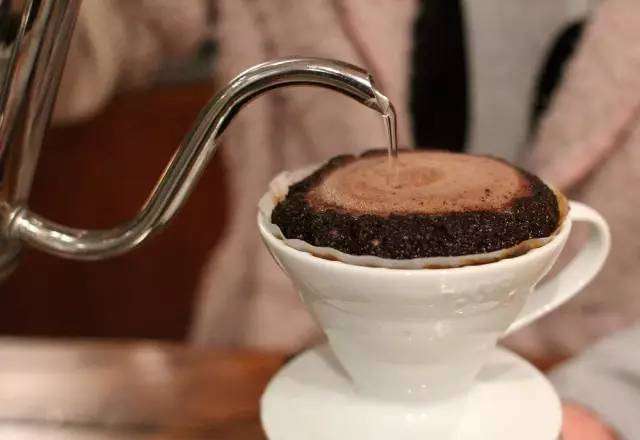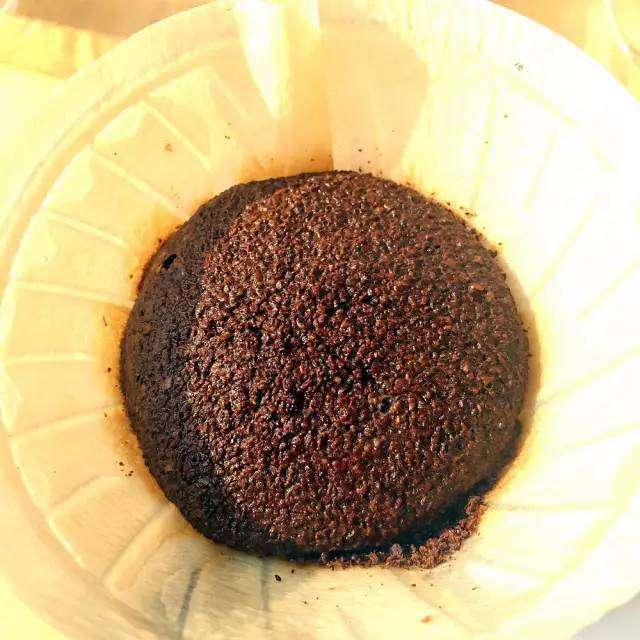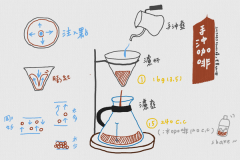The step of making coffee by hand illustrates the purpose of steaming. The correct posture of steaming and injecting water.

Professional coffee knowledge exchange more coffee bean information please follow the coffee workshop (Wechat official account cafe_style)
What is the function of steaming coffee by hand? what are the steps of steaming
Steaming is a very important link in the process of making hand-brewed coffee. Good steaming can fully infiltrate the coffee powder and activate the coffee activity, thus making the coffee extraction process more smooth. So how to do a good steaming?
Steaming, which is often expressed as Bloom in English instructions, refers to the preparatory action of wetting a small amount of hot water evenly on the surface of coffee powder during hand flushing before formal water injection.
There are two purposes of steaming:
First, in order to release the gas in the coffee particles, mainly carbon dioxide. Generally speaking, the closer it is to the baking time, the more bubbles usually occur during prepreg. On the other hand, the coffee beans with deeper roasting degree will release more gas in the steaming process than the coffee beans with lower roasting degree because of less water content.
Second, if the coffee particles after exhaust gas can be evenly absorbed and saturated, the subsequent extraction can be uniform. In short, during steaming, the air between the coffee powder particles expands and releases a large amount of carbon dioxide, while a short gap layer between the coffee powder particles will provide the space needed for hot water to pass through the powder layer during formal water injection.
If the initial step of hand flushing is less steaming, a large amount of hot water will follow a local and a small number of waterways through the powder layer, so that the dripping time will be longer, which may lead to excessive extraction, because the extraction time is longer and more substances are dissolved. the taste may be more sour and irritating, or full of miscellaneous taste. However, once you can pay attention to the action of steaming and then start formal water injection, the hot water can pass through the filter layer evenly composed of coffee powder, and then achieve the purpose of uniform extraction.
The following points will be conducive to the smooth achievement of steaming:
1. Before steaming with water, make sure the coffee powder is as horizontal as possible in the filter screen or filter paper.
two。 When steaming, the force of injecting water is not too strong, gently.
3. The amount of water used in steaming should be 10% of the total water. For 240 milliliters of coffee, the amount of water needed for steaming is about 24 milliliters.
4. In the process of steaming, there is as little extract as possible; when there is too much extract in the kettle, the amount of water injected should be reduced, or attention should be paid to the degree of grinding.
One: the appropriate water temperature.
Coffee needs to be made with hot water at the right temperature, and so is steaming. Too high water temperature (above 95 degrees) will destroy part of the flavor characteristics of coffee in the process of coffee powder infiltration, resulting in turbid taste of extracted coffee, while too low water temperature (below 80 degrees) will lead to insufficient steaming and insufficient activation of coffee, resulting in monotonous and unrich taste of extracted coffee. Generally speaking, it is more appropriate to keep the water temperature of extracted coffee at 83 mi 93 degrees, and the water temperature of steaming should also be in such a range.
Two: the right amount of water.
Steaming is just a preparation step before you really start watering and extracting, just to infiltrate the coffee powder and activate its flavor properties. So the right amount of water is very important, because strictly speaking, this is not an extraction. If there is too much water, see the coffee liquid flowing out, so that the extraction process has already begun, and the steaming process becomes short and insufficient. What happens if there is too little water? Although there is no drop of coffee liquid, we can see that the dry powder still exists. Even if there is no dry powder on the surface, there must be insufficient steaming in the bottom and middle part of the powder layer. This can not fully stimulate the taste characteristics of coffee. The right amount of water should not only ensure that the coffee powder is fully infiltrated, but also be careful not to cause the coffee to be extracted excessively. In general, it is better to drop a few drops of coffee liquid or a thin layer at the bottom of the coffee container.
Three: the right time.
The key role of steaming is to stimulate the activity of coffee powder, with the right water temperature, the right amount of water is still not enough, time control is also important. Steaming for too long will lead to coffee powder soaking for too long, coffee powder taste characteristics are fully stimulated, bad taste characteristics also become active, and good flavor components begin to disappear after full infiltration. If the steaming time is not enough, it will obviously cause insufficient steaming, and the taste characteristics that have not been fully awakened will soon begin to be extracted, and the taste can not be fully expressed. Steaming time for 25 seconds is appropriate, or according to the naked eye to judge the degree of expansion of coffee powder, about to expand to the maximum time to start extraction, do not wait until the expansion to the maximum before starting, then the internal coffee powder may have been steaming too much.
Four: the correct way of steaming.
Steaming, of course, can only be called steaming if the coffee powder is suffocated. This puts forward the requirement for the way of steaming water injection. Coffee production will generally draw a circle from the center to the outside to extract, steaming should also be used in this way. However, it should be noted that when steaming, the water should be evenly distributed on the coffee powder and should not be poured directly on the filter paper. What is the effect of pouring it directly on the filter paper? When the filter paper is attached to the filter, the heat has nowhere to go, it will break through the coffee powder layer and form a hole, the cold air will enter, and the steaming process will be destroyed, so the good taste of the coffee will not be extracted so easily.
The above are just a few simple elements that should be paid attention to. The actual production of coffee should also be adjusted or selected according to the actual situation. For example, fresh coffee beans are ground into powder. Coffee powder can be fully activated without too high water temperature, because the activity of beans is very high, and beans stored for a long time after baking should be properly steamed with higher water temperature. only in this way can the flavor characteristics of beans which are not very active be activated. In short, steaming is a very important link, serious treatment will make the whole coffee making process more smooth and successful.
Whether a cup of hand-brewed coffee has a pleasant flavor depends largely on whether a good filter layer is formed, except for the nature and freshness of the beans, while steaming will determine whether the hot water can pass evenly through the coffee powder. In Bloom is not only the prelude to coffee extraction, but also one of the key steps that can not be ignored in coffee extraction.
The key to making coffee lies in how to control and balance the amount of extraction of various ingredients in roasted beans to make coffee.
Hand-brewed coffee is a process of flavor extraction and filtration at the same time, and the extraction takes place at the center of pouring water. The more water, the more extraction. Newly roasted coffee beans will produce more carbon dioxide, these gases are not conducive to the full contact between water and coffee powder to complete the extraction, so it is necessary to stew first to avoid uneven extraction of coffee powder and affect the efficiency.
[novice question]
What is the correct posture of steaming and water injection? Why do hamburgers always collapse quickly?
In fact, the words of hamburgers have nothing to do with the taste, the possible reasons why they are easy to collapse:
1. Oversteaming
2. Excessive water injection after steaming.
3. Bean baking is relatively shallow.
It will collapse soon after steaming the hamburger, there should be a technical relationship, such as strong water injection to break the powder layer or too much water injection. The best amount of stuffy steam is with the amount of powder: for example, 15g powder is steamed with 20g or 30g water, and the amount of water is too little when steaming, the coffee powder at the bottom of the filter cup is still dry, and it is especially easy to produce large "volcanic bubbles" when reinjecting water.
There will be a lot of bubbles after the first injection of hand-made coffee after steaming. Do you need to stop injecting water at this time?
The main reason for bubbles is that coffee is relatively fresh and contains more carbon dioxide, so it will produce a large amount of carbon dioxide emissions. Therefore, the production of large bubbles, because carbon dioxide material is not allowed in water under atmospheric pressure, the most important role of steaming is to wet the powder evenly, so that carbon dioxide is discharged to ensure uniform extraction during water injection.
If there is still a large amount of exhaust when injecting water, it should be caused by a small amount of steaming water, or a short steaming time, or uneven steaming.
If the steaming is not in place, even if the water injection is stopped, the final extraction result will be affected. Uneven extraction may lead to low extraction rate and uneven taste.
Coffee beans (powder) are not fresh and steamed, won't there be hamburgers?
The continuous expansion of the coffee powder layer during stewing, like hamburgers, is due to the rich carbon dioxide in the freshly roasted coffee powder cells, which are released in large quantities in an instant under the action of hot water. This shows that the coffee powder is fresh and effective. If you don't see an expanding hamburger during stewing, it means that the coffee may have been roasted for too long, causing the carbon dioxide in the cells inside the coffee beans to be released naturally, which means that the coffee beans are no longer fresh.
Generally speaking, in the normal spring and autumn season, the carbon dioxide in roasted coffee beans will escape about 50% after a week, about 70% after two weeks (about a week in summer), and almost all carbon dioxide will be released after 90 days, which shows that the coffee beans are almost dead, which is a phenomenon that no matter how advanced modern packaging technology can stop. Hand-made drip coffee pays special attention to the freshness of beans, so it is best to buy beans that are not baked until an order is placed, so as to ensure that your roasted beans are within the shelf life and are best consumed within 45 days.

.
Important Notice :
前街咖啡 FrontStreet Coffee has moved to new addredd:
FrontStreet Coffee Address: 315,Donghua East Road,GuangZhou
Tel:020 38364473
- Prev

Is your hand flushing method correct? The recommended range of water temperature is 81-92 degrees.
Professional coffee knowledge exchange more coffee bean information please follow the coffee workshop (Wechat official account cafe_style) the relationship between hand brewing water temperature and extraction tools as well as the freshness of coffee beans. I believe that many coffee lovers like to brew coffee by hand, on the one hand, they can experience the fun of brewing coffee, on the other hand, they can enjoy a cup of coffee with individual flavor, but you know that your hand brewing method is correct.
- Next

How to control the direction and speed of water injection for hand-brewed coffee? The common mistake of making coffee by hand
Professional coffee knowledge exchange more coffee bean information Please pay attention to the seven factors affecting hand-brewed coffee in the coffee workshop (official Wechat account cafe_style) Common mistakes in hand-brewed coffee bean error 1: a well-grinded bean grinder can ensure a uniform thickness of coffee powder. If the coffee powder is uneven and the fine powder is too much, it will make the coffee taste not pure enough. That hand flush
Related
- Beginners will see the "Coffee pull flower" guide!
- What is the difference between ice blog purified milk and ordinary milk coffee?
- Why is the Philippines the largest producer of crops in Liberia?
- For coffee extraction, should the fine powder be retained?
- How does extracted espresso fill pressed powder? How much strength does it take to press the powder?
- How to make jasmine cold extract coffee? Is the jasmine + latte good?
- Will this little toy really make the coffee taste better? How does Lily Drip affect coffee extraction?
- Will the action of slapping the filter cup also affect coffee extraction?
- What's the difference between powder-to-water ratio and powder-to-liquid ratio?
- What is the Ethiopian local species? What does it have to do with Heirloom native species?

